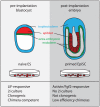The liberation of embryonic stem cells
- PMID: 21490948
- PMCID: PMC3072365
- DOI: 10.1371/journal.pgen.1002019
The liberation of embryonic stem cells
Abstract
Mouse embryonic stem (ES) cells are defined by their capacity to self-renew and their ability to differentiate into all adult tissues including the germ line. Along with efficient clonal propagation, these properties have made them an unparalleled tool for manipulation of the mouse genome. Traditionally, mouse ES (mES) cells have been isolated and cultured in complex, poorly defined conditions that only permit efficient derivation from the 129 mouse strain; genuine ES cells have not been isolated from another species in these conditions. Recently, use of small molecule inhibitors of glycogen synthase kinase 3 (Gsk3) and the Fgf-MAPK signaling cascade has permitted efficient derivation of ES cells from all tested mouse strains. Subsequently, the first verified ES cells were established from a non-mouse species, Rattus norvegicus. Here, we summarize the advances in our understanding of the signaling pathways regulating mES cell self-renewal that led to the first derivation of rat ES cells and highlight the new opportunities presented for transgenic modeling on diverse genetic backgrounds. We also comment on the implications of this work for our understanding of pluripotent stem cells across mammalian species.
Conflict of interest statement
The authors have declared that no competing interests exist.
Figures
References
-
- Evans MJ, Kaufman MH. Establishment in culture of pluripotential cells from mouse embryos. Nature. 1981;292:154–156. - PubMed
-
- Bradley A, Evans M, Kaufman MH, Robertson E. Formation of germ-line chimaeras from embryo-derived teratocarcinoma cell lines. Nature. 1984;309:255–256. - PubMed
-
- Capecchi MR. Gene targeting in mice: functional analysis of the mammalian genome for the twenty-first century. Nat Rev Genet. 2005;6:507–512. - PubMed
Publication types
MeSH terms
Grants and funding
LinkOut - more resources
Full Text Sources
Other Literature Sources
Miscellaneous


